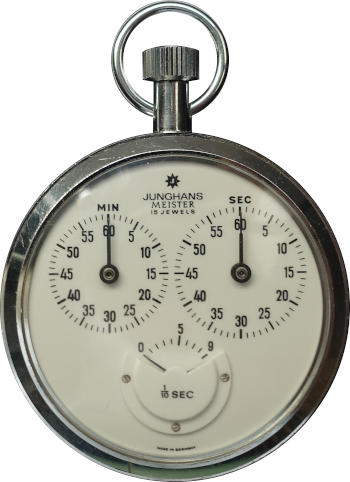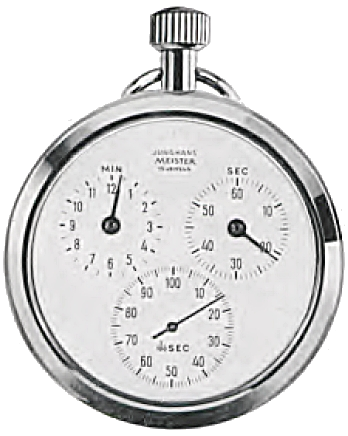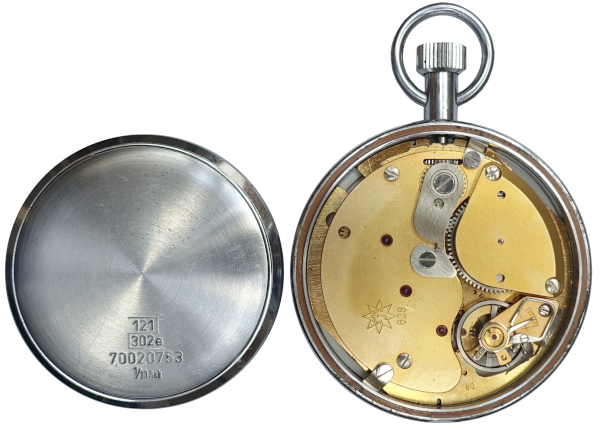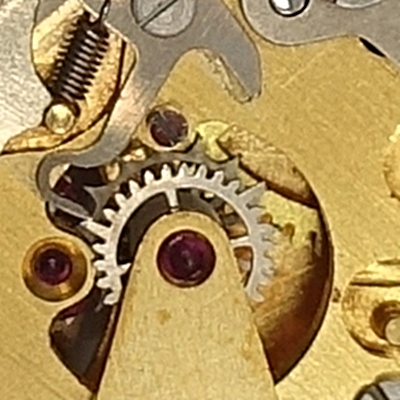Some time ago, I presented the large Junghans triple-circuit laboratory stopwatches. This time, I’m talking about their little sisters in pocket watch format with the Junghans J28 movement. The triple-circuit dial of this watch is so distinctive that you’ll recognize it at first glance.
Junghans triple-circuit laboratory watches were sold from 1950 onwards, and the oldest reference to the triple-circuit pocket watch can be found in a Junghans catalog from 1956. However, they were probably built from 1955 onwards, and they were obviously a great success, as they were built until 1989, i.e. over a period of more than 30 years.
Information on the history of triple-circuit stopwatches and their developer Hans Schlenker (1906 – 1984) can be found in the article on Junghans triple-circuit laboratory stopwatches
The triple-circuit stopwatch as a pocket watch was available in the following versions:
| Reference | Movement | Function |
|---|---|---|
| 128/3101 (old) 028/3101 (new) | J28 = 628.00 7 jewels 36.000 A/h | Stopwatch for recording one-time processes. 1/10 seconds display. Display range: 60 minutes. Metal case. |
| 028/3202 (red) 028/3203 (blue) 028/3204 (anthracite) | 628.00 7 jewels 36.000 A/h | Stopwatch for recording one-time processes. 1/10 seconds display. Display range: 60 minutes. Makrolon plastic case. |
| 128/3105 (old) 028/3105 (new) | J28 = 628.00 7 jewels 36.000 A/h | Stopwatch for recording one-time processes. 1/10 seconds display. Display range: 60 minutes. Metal case. Like 128/3101. Approved for official calibration under the approval number 121 301e. Approval number, watch number and half-oscillation period of the balance engraved on the back. Milling for attaching the calibration seal to the bottom of the case. |
| 128/3501 (old) 028/3501 (new) | J28/1 628.01 15 jewels 36.000 A/h | Stopwatch for recording one-time processes. 1/10 seconds display. Display range: 60 minutes. Metal case. “Meister” (Master) stopwatch. Gilded plates. |
| 128/3504 (old) 028/3504 (new) | J28/1 = 628.01 15 jewels 36.000 A/h | Stopwatch for recording one-time processes. 1/10 seconds display. Display range: 60 minutes. Metal case. “Meister” (Master) stopwatch. Gilded plates. Like 128/3501. Tested by the Physikalisch-Technische Bundesanstalt (German Federal Physical Technical Institute) and supplied with an official test certificate. Engraved number on the outside of the case back. |
| 128/3505 (old) 028/3505 (new) | J28/1 = 628.01 15 jewels 36.000 A/h | Stopwatch for recording one-time processes. 1/10 seconds display. Display range: 60 minutes. Metal case. “Meister” (Master) stopwatch. Gilded plates. Like 128/3501. Approved for official calibration under the approval number 121 302e. Approval number, watch number and half-oscillation period of the balance engraved on the back. Milling for attaching the calibration seal to the bottom of the case. |
| 128/2501 (old) 028/2501 (new) | J28/11 = 628.11 15 jewels 360.000 A/h | Stopwatch for recording one-time processes. 1/100 seconds display. Display range: 12 minutes. Metal case. “Meister” (Master) stopwatch. Gilded plates. |
| 128/3111 (old) 028/3111 (new) | J28/2 = 628.02 7 jewels 36.000 A/h | Addition stopwatch for recording various consecutive processes. 1/10 seconds display. Display range: 60 minutes. Metal case. |
| ? | J28/20 15 jewels | Stopwatch ‘Worktimer’ for recording one-time processes. 1/1000 minutes display (corresponds to 6/100 seconds). Metal case. Only one specimen known: Deutsches Uhrenmuseum Furtwangen |
The movement was originally named J28. In 1962, Junghans renamed its movements and replaced the J with a 6, turning the J28 into the 628.
The prefix of the reference, called ‘group’ by Junghans, was 128 until at least 1965, when at the latest in 1969 it was changed to 028.




Most Junghans three-circuit stopwatches have a chrome-plated metal case with a diameter of 55 mm (see examples above). However, there are also versions with plastic cases:

The watches in the metal case have a pressed-on cover, while the Meister versions have an additional dust cover underneath.

The movement just shown has a swan-neck fine regulator on the balance cock. Since there are also many J28/628 movements without a swan neck, I initially assumed that this was only fitted to the “Meister” versions with 15 jewels. However, there are “Meister” versions without swan necks as well as simple 7 jewel movements with swan necks. The presence of the swan neck is also not related to whether the model was suitable for official calibration or not. It therefore remains a mystery.
After removing the movement, the dial needs to be removed.
Professional tip:
Do not lift off the seconds and minutes hands, but simply pull them up a little. This causes the hearts on the back to detach from the corresponding pivots on the movement. The hands can thus remain on the dial. This has the great advantage that these hands do not have to be reset later. The hearts ensure that they are automatically positioned correctly. The 1/10 seconds hand can be removed as normal. And as with the three-circuit laboratory watches, this consists of three hands, two of which are always covered by the small cover plate.

Let’s take a closer look at one of the movements, a Junghans J28/1:

The bridge side (right in the picture) is quite unspectacular. All the wheels are under the bridges, only the rocking bar and the click can be seen above. Under the bridges it looks like this:

Normally, the barrel rim drives the center wheel. In this case, the center wheel sits directly on the back of the mainspring barrel:

The pivot of the center wheel carries the minute heart (see below) and this in turn carries the minute hand of the stopwatch. The minute hand therefore rotates continuously and does not jump from one minute to the next, as is the case with many chronographs.
The center wheel drives the seconds wheel on the opposite side via an auxiliary wheel, on whose pivot sits the seconds heart with the seconds hand. In a conventional movement, this intermediate wheel would be referred to as the third wheel.
From the seconds wheel, a second auxiliary wheel leads to the escape wheel, which is also the counting wheel for the 1/10 seconds display. The corresponding hand is therefore located on its pivot.
More interesting is the dial side of the movement, where the stopwatch mechanism, the so-called cadrature, is located:

What happens when you press the button on the stopwatch?
This pushes the operating lever1a downwards, the operating lever in turn pushes the column wheel2aone position further. With its spring, the operating lever arm1bensures that the operating lever then returns to its original position. The column wheel jumper2bengages permanently in the column wheel and locks it in the respective position so that it does not move between shifting operations.
The column wheel consists of two levels. At the bottom is a gear rim into which the operating lever and the column wheel jumper engage. The columns are positioned vertically on top of this. These and the gaps between them ensure that the levers responsible for the various shifting operations – start, stop, reset – are always in the correct position.


The following elements are involved here:
- Minute heart hammer3a
- Start lever5
- Stop lever6
The minute heart hammer3apresses against the minute heart4aduring the reset. The minute hand sits on this. The heart shape ensures that the hand remains exactly at zero when it is reset. At the same time, the minute heart lever also presses the seconds heart hammer3bagainst the seconds heart4b so that the second hand is also set to zero.
At first glance, the start lever5is thought to be a seconds stop that stops the balance when stopping. On closer inspection, however, you realize that it is not used when stopping but when starting. It gives the balance a little push. However, the start lever was not installed in all three-circle stopwatches, not even in all Meister (master) models. I have not yet been able to identify any logic according to which the start lever is present or absent.
In contrast, the stop lever6is crucial for the functioning of the stopwatch, as it engages with the counting wheel7mounted on the escape wheel. This has alternately nine short teeth and then one longer tooth. During the stopping process, the stop lever engages deeply enough to stop it between two short teeth. This allows one of the three 1/10 seconds hands to indicate the tenths of a second. During the reset process, the stop lever does not engage deeply enough so that it can only stop the next long tooth. This means that one of the three 1/10 seconds hands always stops exactly at 0. And that’s without a heart and heart hammer! In both cases, i.e. when stopping and resetting, the stop lever blocks the escape wheel, so the balance remains at rest.

The following image shows the individual elements of the switching operations
Zero position (reset) -> Start -> Stop (click to enlarge)
Finally, for a better overview, the position of the most important elements is shown in a table:
| Heart hammers | Start lever | Stop lever | |
|---|---|---|---|
| Zero position | push against hearts | right | engages in long tooth |
| Start | no contact | left | no contact |
| Stop | no contact | right | engages in short or long tooth |

